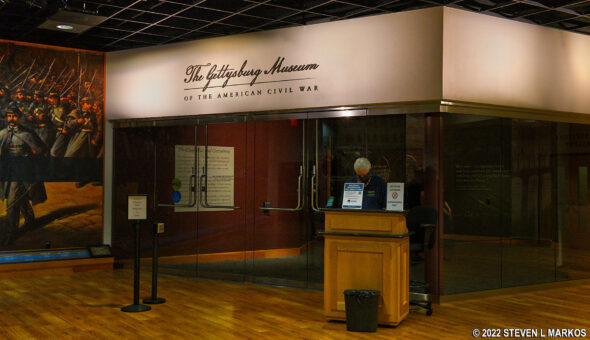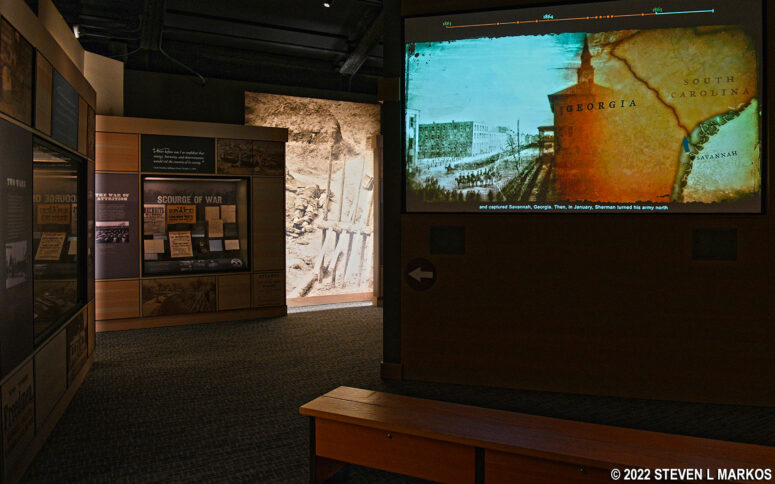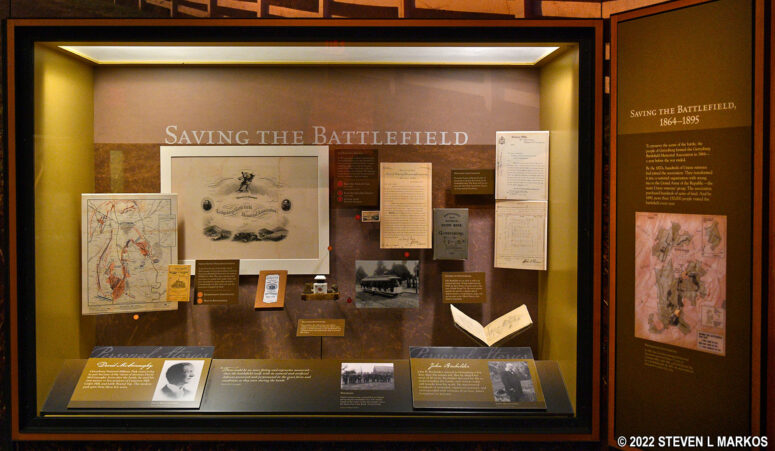TICKET INFORMATION
There is a fee to enter the Gettysburg Museum at Gettysburg National Military Park. Tickets can be purchased at the Gettysburg Foundation’s ticket desk inside the Visitor Center or in advance on the Foundation’s Film, Cyclorama, and Museum Experience web page. Tickets also include the Cyclorama and Film. Because the Visitor Center is not a National Park Service facility, National Park Passes of any kind are not valid for ticket purchases or discounts. There is a $1 discount for seniors, veterans, and AAA members. Active military personnel get in free. There are also reduced prices for children.
The Gettysburg Museum is massive in size, and while not quite on the scale of a Smithsonian Museum, it is without a doubt one of the largest within the National Park system. If you aren’t willing to set aside at least an hour for the museum, you are just wasting your money. A Civil War buff could spend five hours or more in the museum. The museum ticket is good all day, so if you want to take a break and come back later, you can do so. I highly recommend visiting the museum and seeing the film and cyclorama if you really want to learn about the Battle of Gettysburg. Having some knowledge of the battle will go a long way in helping you understand what you are seeing once you venture out to explore the actual battlefield.
GETTYSBURG MUSEUM
While the film A New Birth of Freedom (the film shown as part of the Film and Cyclorama Experience) provides the highlights of the Civil War and the Battle of Gettysburg, the Gettysburg Museum provides the details. The museum follows the same plot structure as the film, with each of its eight sections focusing on a particular topic: the roots of the Civil War and the events and battles leading up to the Battle of Gettysburg; the battle itself, one room for each day; the aftermath of the battle; a recap of the Civil War events and battles after Gettysburg; an exhibit on Abraham Lincoln; and the preservation of the battlefield and the creation of Gettysburg National Military Park. Exhibits include information panels populated with reproductions of historical photographs and newspaper clippings, plenty of actual artifacts found on the battlefield, and multiple video presentations and interactive exhibits. There is only one way to go through the museum, so you don’t have to worry about whether you missed something or if you are visiting the exhibits out of order.
An important part of the museum is nine documentary video presentations, each lasting four to ten minutes. Watching all of these can add considerable time to you visit. However, some—not all—of the documentaries are nothing more than derivatives of A New Birth of Freedom. For example, Conceived in Liberty?, a six-minute film about slavery’s role in the Civil War, shows in the first exhibit room on a large, panoramic screen. It is in essence an alternate version of the same information covered in A New Birth of Freedom. Some of the narration is identical, only this time it’s not spoken by Morgan Freeman. While it never hurts to get the information twice, if you’ve already seen A New Birth of Freedom, you can skip past most of the museum films if you want to save some time.

Visitors watch one of nine short documentary films shown at the Gettysburg Museum, Gettysburg National Military Park
There are also a number of interactive touch-screen computer exhibits. In the pre-Gettysburg section of the museum, there is an interactive exhibit where you can listen to dozens of speeches given by pro-Union and pro-Confederate politicians and well-known personalities of the day (read by modern voice actors). There is an interactive exhibit in each of the three rooms covering the battle that details specific troop location at any given time that day. These are geared more for the true Gettysburg buff, but the typical tourist might want to spend a few minutes at one just to see what information is available.
As mentioned, the first exhibit room at the Gettysburg Museum covers the roots of the Civil War and events prior to the Battle of Gettysburg. There is one unique documentary that I found very helpful that recaps all of the major pre-Gettysburg battles. Unlike the first film in this room—the one on the issue of slavery—the information in this film is not covered in A New Birth of Freedom. The film is seven minutes long. Another five-minute film details the Union and Confederate armies’ preparation in the days just before the Battle of Gettysburg.
Not everything in the first exhibit room is about the early Civil War battles. Here you will find information on the different branches of the army—infantry, cavalry, and artillery—recruitment, soldier life, uniforms, major personalities of the time, and civilian life during the war, particularly in Gettysburg shortly before the battle. Citizens knew the Confederates were coming, and it is interesting to learn what they were thinking and doing to prepare for a likely invasion.

Exhibit on soldier life during the Civil War in the Gettysburg Museum at Gettysburg National Military Park
The Battle of Gettysburg itself spans three exhibit rooms, one for each day of the battle. There is a video dedicated to each day that reuses the animated battle map footage from A New Birth of Freedom but imparts more detailed information…and no Morgan Freeman. You can skip each one of these if you are well versed in the battle. The films run about five minutes each.
The section of the Gettysburg Museum that I found the most interesting covers the aftermath of the battle. Topics include Civil War-era medicine and hospitals, burying the dead, and the overall destruction brought upon the town of Gettysburg. There is also a four-minute film that brings to life diary excerpts written by Gettysburg residents directly after the battle. This content is not found in A New Birth of Freedom, so be sure to check it out.
Something that struck me as overlooked by most people when they think about the Battle of Gettysburg is that the town of Gettysburg had just 2,400 residents in 1863. With that few people, it’s fairly easy to dispose of human and animal waste without much fear of festering diseases. Now just imagine over 150,000 human beings rolling into town on a day’s notice, not to mention an estimated 75,000 horses and mules, with everyone and everything peeing and pooping everywhere. With that much waste, combined with thousands of rotting corpses, it’s a wonder the plague didn’t break out and kill everyone. Many residents just up and left and never returned.
The smallest exhibit room is the one on Lincoln and the Gettysburg Address. Exhibits include reproductions of a few Executive Orders that Lincoln signed, a pardon from execution of a Union deserter, and a collection of quotes written by journalists about Lincoln’s Gettysburg Address speech, both praising and ridiculing it. The speech was critiqued no differently than if it were the latest theatrical performance.
The seventh section of the Gettysburg Museum details the major events of the Civil War after the Battle of Gettysburg up until the war’s end. A film with unique content recaps the major battles, and in seven minutes you can get a good overview of the fighting after Gettysburg. A second 10-minute film, also with unique content, covers the reconstruction period and ensuing Jim Crow laws in the South once the federal government butted out. It is always interesting to learn the roots of common phrases. The term Jim Crow comes from a character created in the late 1820s by Thomas Rice, a white comedian who popularized blackface performances with his character Jim Crow, a poor slave who had a limp. The show was a parody of every degrading stereotype associated with the Black race, and it became so popular that it made Rice the highest paid actor of his time. The term Jim Crow went on to become the name for the segregation laws.
In addition to the major battles, topics include Civil War POW camps, the 1864 election in which Lincoln was elected for a second term, his assassination just 42 days after his second term began, and Lee’s surrender at Appomattox Courthouse on April 9, 1865.
The final section of the museum deals with the preservation of the Gettysburg battlefield. Before the war even ended, the citizens of Gettysburg formed the Gettysburg Battlefield Memorial Association, so there were people who wanted to preserve the battlefield right from the start. The association purchased and preserved 17 acres in 1863. However, it wasn’t until the 1870s that money was available for large land purchases, and by 1895, 522 acres were protected. At this time the Gettysburg Battlefield Memorial Associated disbanded and turned over the land to the federal government, which resulted in the creation of Gettysburg National Military Park. Like most battlefield parks, Gettysburg originally fell under the management of the U. S. War Department, for the National Park Service wasn’t even created until 1916. The park officially became part of the National Park system in 1933.
With a few exceptions, use of any photograph on the National Park Planner website requires a paid Royalty Free Editorial Use License or Commercial Use License. See the Photo Usage page for details.
Last updated on January 25, 2025















